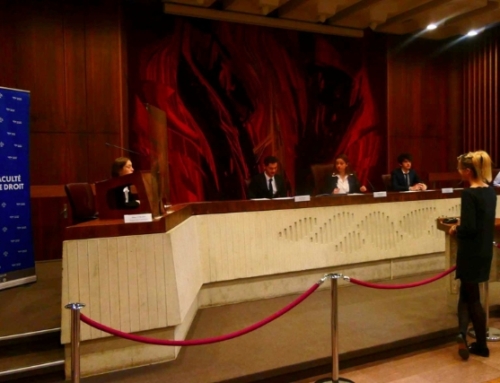After the summer break, the virus is unfortunately still with us. While we’ve regained some of our freedoms, it’s clear that the health crisis has caused a major upheaval in learning methods from school to university. Frédérique Vidal, the French Minister for Higher Education, announced back in July that she wanted to see a return to 100% face-to-face teaching, and she confirms this in the run-up to the new academic year, but it’s undoubtedly prudent to be prepared for all eventualities.
The university presidents meeting at the conference of university presidents on August 26 and 27 at the University of Littoral Côte d’Opale, are also anticipating the possible return of more restrictive measures, and in particular gauges based on changes in sanitary conditions.
It’s essential that students get back to university and campus life, so they can enjoy the student experience and get back to work. However, it’s also important to remember what they’ve been through for almost two years. They had to adapt to a new way of taking their courses, at a distance. They sometimes had to give up their student accommodation to return to their parents’ home to study. They gained in independence and autonomy by being supervised much less, or differently. They’ve learned to communicate at a distance, and have even created well-organized communities to keep in touch. They’ve become resilience pros. So, should we focus solely on a face-to-face return when we can offer them both?
Numerous existing EdTech solutions, some of them free, facilitate the student experience both in the classroom and at a distance. For universities that adopt them and deploy them on their campuses, the student experience is greatly enhanced. In particular, some allow students to make the most of distance learning while retaining the advantages of access to an open campus. Would greater flexibility, easier geographical mobility or access to asynchronous teaching be a plus for some students?
So what are the essential tools you need to offer this enriched experience?
-
A high-performance virtual classroom!
Distance learning is a very different experience from face-to-face courses. In the classroom, the sources of interest are diverse. They may come from the teacher, from students interacting with the course or simply from the environment, all of which serve to heighten attention. At a distance, both the student and the teacher are faced with a single channel for the circulation of information. For the teacher, this means adapting the course to make it more dynamic. Virtual classroom solutions not only make it possible to follow a course remotely, but also to create a more engaging experience with features that create interaction! In this way, students, who are less supervised at a distance and often less active, regain a sense of rhythm and depth in their learning! Today, there are technologies that make it easy to manage your class and create time for exchanges at different levels, so that everyone can stay focused!
Discover three virtual classroom solutions that boosted distance learning during the health crisis:
- A solution made in France : TeachReo! TeachReo is a videoconferencing platform dedicated to education, 100% hosted in France! Based on BBB technology, it enables students to benefit from a more interactive course with the possibility of taking polls, using a collaborative board, creating private rooms, using chat or emojis to express themselves easily!
- An international solution : Zoom! Zoom was the most widely used solution during the crisis, thanks to its high capacity. It features a digital whiteboard, screen sharing, file exchange, chat and the ability to create sub-group rooms!
- An open-source solution : Jitsi! Jitsi Meet is a free, open-source solution. End-to-end encrypted, it enables simultaneous screen sharing by several participants, and is easy to integrate with most collaborative work solutions. Intuitive to use, Jitsi features all the essential functions: screen sharing, “raise your hand”, and chat between participants.
2. Interactivity!
Whether distance or face-to-face, the watchword of 2021-2022 will be Interactivity! Students are used to interacting with content throughout the day, sending and sharing information at breakneck speed, and are always connected. Why not harness this power in the classroom? Solutions now exist for both computers and smartphones to enable students to interact directly with the course. In this way, they become players in their own learning and improve their engagement! Teachers are also able to obtain a more detailed analysis, thanks to data collection, of notions understood or not. This enables them to target their lessons at the group’s difficulties, or to provide more specific help to a student who may have missed an essential concept. The benefits are numerous on both sides!
Discover two EdTech solutions for creating interaction :
- A solution made in Belgium : Wooclap! Wooclap is a stand-alone solution that can be integrated into LMSs. It lets you create interaction from your computer or smartphone, with quizzes, polls or experience sharing to help you progress together! Fun and interactive, it’s the solution that wakes up your courses!
- An international solution : Kahoot! is a Swedish solution for interactive quizzes and games. It’s a simple way to challenge your students on the concepts they’ve learned in class! A simple way to boost student concentration, especially if you promise a reward for the winner!
To find out more about Wooclap and understand the benefits of interaction in the classroom, watch the replay of this round table with Fabien Maurin, Wooclap’s French market manager, Tristan Lafosse, a student at University of Créteil, and Pierre Boulet, digital vice-president at the University of Lille!
Discover the benefits of interaction in the student experience in this round-table discussion featuring Fabien Maurin, Wooclap’s French market manager, Tristan Lafosse, a student at University of Créteil, and Pierre Boulet, digital vice-president at the University of Lille:
3. A virtual collaborative space!
In the same spirit of interactivity, we believe it’s important to provide students with all the tools they need to collaborate effectively. To this end, platforms have been developed that bring together the best features to enhance group work, enabling students to push back the walls of the classroom! They benefit from a space where they can exchange ideas as well as study, and where they can find each other easily, despite geographical distance! They gain in flexibility and efficiency. These solutions can also be used in the classroom. They enable users to improve their skills in organizing group work and project management!
Discover three collaborative workspace solutions :
- A solution made in France : Klaxoon! Klaxoon is a collaborative platform that brings together all the tools needed for group work. It’s an effective solution for engaging and simplifying student work, but not only that: Klaxoon is above all a tool that enables millions of people around the world to work more efficiently! And what could be better than learning at university to work the way we’ll be working tomorrow?
- An open-source solution : Gather Town! Gather Town is an immersive open-source collaborative solution. It’s possible to create an entire virtual campus in 2D, where students can meet, with amphitheater spaces integrating a videoconferencing solution, or private collaborative spaces, enabling students to work together, amongst themselves! Designed to prevent remote working from isolating participants too much, Gather lets you stay in the environment even without taking part in a videoconference. It’s possible to continue working on a project, temporarily alone, before other members of the group join the space, while still seeing other students moving around the campus.
- An open-source solution : OpenBoard! OpenBoard is open source software for schools and universities, enabling interaction and exchange around a whiteboard!
To find out more about Klaxoon and understand all the advantages of a collaborative solution for universities, watch the replay of this round table with Matthieu Poupard, Director of Partnerships at Klaxoon, Lamise Guenni, a student at Sorbonne Université, and Guy Melançon, Vice-President of the University of Bordeaux :
Discover the benefits of a collaborative solution at university with this roundtable discussion, which brought together Matthieu Poupard, Director of Partnerships at Klaxoon, Lamise Guenni, former student at Sorbonne Université, and Guy Melançon, Vice-President of the University of Bordeaux :
4. The whole campus in your pocket!
Did you say flexibility ? Or was it mobility ? These are the key concepts of the new school year. During the crisis, students became more independent. They still need campus life, but they’ve also discovered the possibilities of taking their courses to the beach, the countryside or the top of a mountain. So if they’re offered access to the whole campus directly from their smartphones, it’s easy to imagine their enthusiasm.
Applications are being developed in France and abroad to give all players in the university ecosystem access to campus services, from the library to housing assistance, as well as real-time information via notifications! Today, 95% of students have a smartphone, which they use every day. It’s essential to use this channel to keep them connected to campus life, and to ensure that they can easily access all the services set up by the university at the click of a button, even from a distance!
Discover two mobile application solutions :
- A solution made in France : Appscho! Appscho is a French mobile campus solution! It provides students with a customizable dashboard from which they can access all the services offered by their university. The university can notify or query its students at any time. Appscho is a highly effective means of communication for institutions.
- An international solution : Campus M is a mobile application that transforms your university’s services into a personalized mobile experience! With a strong presence in the U.S. and the U.K., Campus M boasts a highly active community of users who, thanks to a dedicated development kit, can customize their version of the App as they see fit.

5. A video creation solution !
The use of video as a medium for information and entertainment has been growing for over 10 years. An indispensable resource, video has become the most consulted medium. It is also used as a learning medium. Whether face-to-face, distance learning, synchronous or asynchronous, for a course to be engaging, it must be of good quality and meet the expectations of those who will be using it. Nevertheless, video involves a number of stages. From capture to hosting, editing, encoding and subtitling, it’s enough to discourage many a teacher. That’s why solutions exist to make these steps more accessible. With cameras designed to record dynamic images, and hosting solutions that enable interactive video editing, this teaching aid becomes easily accessible to all teachers!
There are so many great made in France options that we won’t tell you about what’s going on elsewhere 😉
- A solution made in France : Kast Revolt by Kalyzée! Kast Revolt is a nomadic solution that lets you forget about technical. This space-saving solution allows users to be mobile and connected throughout the video creation process, from capture to broadcast!
- Another made-in-France solution : Ubicast! Ubicast is a platform for creating and hosting educational videos! This customizable solution enables users to easily record, distribute and store their courses, while also being able to enhance them with chaptering tools, integration of external links and interactive exercises!
- An Open Source solution : Esup-POD! POD is the free video file management solution that can be integrated into your LMS! This tool enables intuitive hosting and classification of educational videos, as well as video enhancement, with tools for chaptering, subtitling, integration of downloadable documents and live broadcasting.
As you can see, these solutions, which we consider essential, whether open source or proprietary, are already available and ready to use. After a year and a half of confinement, students, teachers and support staff need a little more serenity in their daily lives at the university, both in class and remotely. This period of health crisis has highlighted everyone’s need for access to digital tools that are more engaging, more dynamic, or simply more in tune with their daily lives, which are already full of these new technologies! This period has also been an opportunity for the academic world and the EdTech sector to work more closely together to find the right solutions. We hope this will continue, so that we can continue to improve the student experience.






